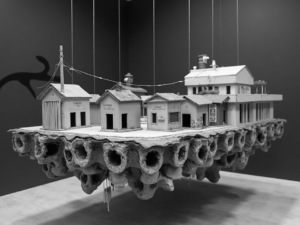I stumbled upon the wonderful story of James Edward Deeds by chance in a secondhand bookstore, and I was able to appreciate how fascinating this artist’s life and work were. Deeds lovingly bound all his drawings in a cardboard and leather portfolio, a gift for his mother. After the album was accidentally discarded in 1970, a boy rescued it from the trash, and thirty-six years later, it came into the hands of artist and collector Harris Diamant, who writes the foreword for the book The Electric Pencil. This work presents the 283 fascinating drawings of Deeds, created on ledger sheets from the Missouri State Hospital No. 3, and reproduced in the sequence of the original album. The Electric Pencil is an astonishing record of the unyielding artistic vision of a man facing the harshest conditions.
Deeds’ subtle, meticulous, and incredibly imaginative pencil and crayon drawings portray an unusual cast of characters: 19th-century dandies, Civil War soldiers, vintage cars, fantastical ships and trains, pastoral landscapes dotted with wandering animals, and extravagant architecture. None of these elements existed in the real landscape of Deeds’ mid-20th-century life; they were representations of his inner world, a poignant tribute from an artist to a faded past.
The story seems to have no clear ending and begins at least three different points. A 14-year-old boy finds a worn portfolio in a dumpster in Springfield, Missouri. Inside are 283 pages of illustrations depicting pastoral scenes filled with oddities, from disproportionately large cats and peacocks to intricate drawings of ships and trains, and an illustration of a baseball team. Most striking are the hypnotic portraits of women dressed in Edwardian style, with disproportionately large eyes and dark hair parted down the middle. The unsigned portfolio is marked with the name of the Missouri State Hospital No. 3. The boy who finds the illustrations does not wish for his name to be linked to the growing fame of these works, but he treasures them for 36 years, until he finally decides to present them to the world through an art market he could barely have imagined in 1970.
James Edward Deeds was born in 1908 in the Panama Canal Zone. He was the oldest of five children of Ed and Clara Deeds, who eventually returned to Missouri. According to his niece, Julie Deeds Phillips, Edward was a sweet but socially awkward young man, ill-suited for farm life. Despite the rural imagery that dominates his drawings, his inclination was artistic. After a conflict with his brother, his father decided to send him to the Missouri School for the Feeble Minded, and later to the Missouri State Hospital No. 3, where he would spend the next 40 years.
During his stay in the hospital, Edward was diagnosed as mentally disabled and schizophrenic, although his family insists that these labels do not reflect the man they knew. A later analysis suggested he might have had an autism spectrum disorder, shedding light on his highly detailed and repetitive work.
Despite the desolate conditions of the hospital, where abuse and an unsanitary environment were reported, Deeds’ works portray a tender and nostalgic world. His drawings, which often reflect a time he barely remembers, do not allude to loneliness or abuse; instead, they create a refuge filled with gentle ladies, lush nature, and friendly animals. As his life progressed, arthritis limited his ability to draw, and the portfolio was inherited by his mother and then by his brother, Clay. Eventually, after a family move, the portfolio ended up in a dumpster in Springfield, devastating the family.
Years later, an anonymous man rescued the portfolio and put it up for sale on eBay. It was bought by a bookseller from Kansas, who in turn sold it to a collector in St. Louis, John Foster. Recognizing the special value of the works, Foster made the most significant purchase of his career and decided to take them to New York. Art dealer Harris Diamant, intrigued by the unknown talent, nicknamed the artist “The Electric Pencil” and sought to uncover his identity. The search concluded when an article in the Springfield News-Leader caught the attention of Julie Deeds Phillips, who recognized her uncle’s works. From there, Deeds’ works began to gain recognition, and his name became a symbol of hidden talent and suffering.
Although Deeds passed away in 1987 without knowing the fame his work would achieve, his legacy continues to resonate in the art world. His drawings remind us that, despite spending most of his life in cold and sometimes cruel institutions, Edward was able to create through his art a world full of warmth and nostalgia. The story of James Edward Deeds serves as a reminder that sometimes art can arise from the most difficult circumstances, and the mystery surrounding his life only adds a deeper nuance to his work. While we may never know all the details of his life, we can affirm that his art speaks of a personal refuge, an expression of beauty and sensitivity amid adversity.









